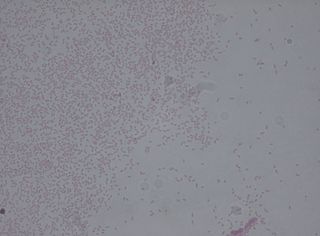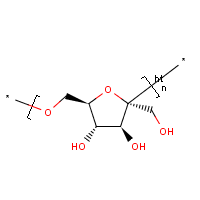
Enterobacteriaceae is a large family of Gram-negative bacteria. It includes over 30 genera and more than 100 species. Its classification above the level of family is still a subject of debate, but one classification places it in the order Enterobacterales of the class Gammaproteobacteria in the phylum Pseudomonadota. In 2016, the description and members of this family were emended based on comparative genomic analyses by Adeolu et al.

Enterobacterales is an order of Gram-negative, non-spore forming, facultatively anaerobic, rod-shaped bacteria with the class Gammaproteobacteria. The type genus of this order is Enterobacter.

Coliform bacteria are defined as either motile or non-motile Gram-negative non-spore forming bacilli that possess β-galactosidase to produce acids and gases under their optimal growth temperature of 35–37 °C. They can be aerobes or facultative aerobes, and are a commonly used indicator of low sanitary quality of foods, milk, and water. Coliforms can be found in the aquatic environment, in soil and on vegetation; they are universally present in large numbers in the feces of warm-blooded animals as they are known to inhabit the gastrointestinal system. While coliform bacteria are not normally causes of serious illness, they are easy to culture, and their presence is used to infer that other pathogenic organisms of fecal origin may be present in a sample, or that said sample is not safe to consume. Such pathogens include disease-causing bacteria, viruses, or protozoa and many multicellular parasites.

Escherichia is a genus of Gram-negative, non-spore-forming, facultatively anaerobic, rod-shaped bacteria from the family Enterobacteriaceae. In those species which are inhabitants of the gastrointestinal tracts of warm-blooded animals, Escherichia species provide a portion of the microbially derived vitamin K for their host. A number of the species of Escherichia are pathogenic. The genus is named after Theodor Escherich, the discoverer of Escherichia coli. Escherichia are facultative aerobes, with both aerobic and anaerobic growth, and an optimum temperature of 37 °C. Escherichia are usually motile by flagella, produce gas from fermentable carbohydrates, and do not decarboxylate lysine or hydrolyze arginine. Species include E. albertii, E. fergusonii, E. hermannii, E. ruysiae, E. marmotae and most notably, the model organism and clinically relevant E. coli. Formerly, Shimwellia blattae and Pseudescherichia vulneris were also classified in this genus.

Enterobacter is a genus of common Gram-negative, facultatively anaerobic, rod-shaped, non-spore-forming bacteria of the family Enterobacteriaceae. Cultures are found in soil, water, sewage, feces and gut environments. It is the type genus of the order Enterobacterales. Several strains of these bacteria are pathogenic and cause opportunistic infections in immunocompromised hosts and in those who are on mechanical ventilation. The urinary and respiratory tracts are the most common sites of infection. The genus Enterobacter is a member of the coliform group of bacteria. It does not belong to the fecal coliforms group of bacteria, unlike Escherichia coli, because it is incapable of growth at 44.5 °C in the presence of bile salts. Some of them show quorum sensing properties.
Cotton fever is a condition that indicates as a fever that follows intravenous drug use where cotton is used to filter the drugs. The condition derives from an endotoxin released by the bacteria Pantoea agglomerans which lives in cotton plants.

Alcaligenes is a genus of Gram-negative, aerobic, rod-shaped bacteria in the order of Burkholderiales.

Gammaproteobacteria is a class of bacteria in the phylum Pseudomonadota. It contains about 250 genera, which makes it the most genus-rich taxon of the Prokaryotes. Several medically, ecologically, and scientifically important groups of bacteria belong to this class. It is composed by all Gram-negative microbes and is the most phylogenetically and physiologically diverse class of Proteobacteria.

Pantoea agglomerans is a Gram-negative bacterium that belongs to the family Erwiniaceae.

Cronobacter sakazakii, which before 2007 was named Enterobacter sakazakii, is an opportunistic Gram-negative, rod-shaped, pathogenic bacterium that can live in very dry places, otherwise known as xerotolerance. C. sakazakii utilizes a number of genes to survive desiccation and this xerotolerance may be strain specific. The majority of C. sakazakii cases are adults but low-birth-weight preterm neonatal and older infants are at the highest risk. The pathogen is a rare cause of invasive infection in infants, with historically high case fatality rates (40–80%).
Pluralibacter gergoviae is a Gram-negative, motile, facultatively-anaerobic, rod-shaped bacterium. P. gergoviae is of special interest to the cosmetics industry, as it displays resistance to parabens, a common antimicrobial agent added to cosmetic products.

Cronobacter is a genus of Gram-negative, facultatively anaerobic, oxidase-negative, catalase-positive, rod-shaped bacteria of the family Enterobacteriaceae. Several Cronobacter species are desiccation resistant and persistent in dry products such as powdered infant formula. They are generally motile, reduce nitrate, use citrate, hydrolyze esculin and arginine, and are positive for L-ornithine decarboxylation. Acid is produced from D-glucose, D-sucrose, D-raffinose, D-melibiose, D-cellobiose, D-mannitol, D-mannose, L-rhamnose, L-arabinose, D-trehalose, galacturonate and D-maltose. Cronobacter spp. are also generally positive for acetoin production and negative for the methyl red test, indicating 2,3-butanediol rather than mixed acid fermentation. The type species of the genus Cronobacter is Cronobacter sakazakii comb. nov.

Levan is a naturally occurring fructan present in many plants and microorganisms. This polymer is made up of fructose, a monosaccharide sugar, connected by 2,6 beta glycosidic linkages. Levan can have both branched and linear structures of relatively low molecular weight. Branched levan forms a very small, sphere-like structure with basal chains 9 units long. The 2,1 branching allows methyl ethers to form and create a spherical shape. The ends of levan also tend to contain a glucosyl residue. Branched levan tends to be more stable than the linear structure. However, the amount of branching and length of polymerization tends to vary among different species. The shortest levan is 6-kestose, a chain of two fructose molecules and a terminal glucose molecule.
Cedecea is a genus of extremely rare bacteria of the family Enterobacteriaceae. The name of this genus was derived from CDC, the abbreviation for the Centers for Disease Control where the initial members of this genus were discovered. This genus resembles no other group of Enterobacteriaceae. Cedecea bacteria are Gram-negative, bacillus in shape, motile, nonencapsulated, and non-spore-forming. The strains of Cedecea appear to be similar to those of Serratia. Both Cedecea and Serratia are lipase positive and resistant to colistin and cephalothin; however, Cedecea is unable to hydrolyze gelatin or DNA.
Enterobacter cowanii is a Gram-negative, motile, facultatively-anaerobic, rod-shaped bacterium of the genus Enterobacter. The species is typically associated with natural environments and is found in soil, water, and sewage. E. cowanii is associated with plant pathogens that exhibit symptoms of severe defoliation and plant death. This species, originally referred to as NIH Group 42, was first proposed in 2000 as a potential member of the family Enterobacteriaceae. The name of this species honors S. T. Cowan, an English bacteriologist, for his significant contributions to the field of bacterial taxonomy.

Phytobacter is a genus of Gram-negative bacteria emerging from the grouping of isolates previously assigned to various genera of the family Enterobacteriaceae. This genus was first established on the basis of nitrogen fixing isolates from wild rice in China, but also includes a number of isolates obtained during a 2013 multi-state sepsis outbreak in Brazil and, retrospectively, several clinical strains isolated in the 1970s in the United States that are still available in culture collections, which originally were grouped into Brenner's Biotype XII of the Erwinia herbicola-Enterobacter agglomerans-Complex (EEC). Standard biochemical evaluation panels are lacking Phytobacter spp. from their database, thus often leading to misidentifications with other Enterobacterales species, especially Pantoea agglomerans. Clinical isolates of the species have been identified as an important source of extended-spectrum β-lactamase and carbapenem-resistance genes, which are usually mediated by genetic mobile elements. Strong protection of co-infecting sensitive bacteria has also been reported. Bacteria belonging to this genus are not pigmented, chemoorganotrophic and able to fix nitrogen. They are lactose fermenting, cytochrome-oxidase negative and catalase positive. Glucose is fermented with the production of gas. Colonies growing on MacConkey agar (MAC) are circular, convex and smooth with non-entire margins and a usually elevated center. Three species are currently validly included in the genus Phytobacter, which is still included within the Kosakonia clade in the lately reviewed family of Enterobacteriaceae. The incorporation of a fourth species, Phytobacter massiliensis, has recently been proposed via the unification of the genera Metakosakonia and Phytobacter.

The Morganellaceae are a family of Gram-negative bacteria that include some important human pathogens formerly classified as Enterobacteriaceae. This family is a member of the order Enterobacterales in the class Gammaproteobacteria of the phylum Pseudomonadota. Genera in this family include the type genus Morganella, along with Arsenophonus, Cosenzaea, Moellerella, Photorhabdus, Proteus, Providencia and Xenorhabdus.
Pluralibacter is a genus of Gram negative bacteria from the family of Enterobacteriaceae. The genus consists of two species, P. gergoviae and P. pyrinus. Both species were originally classified in the genus Enterobacter but were reclassified into the novel genus Pluralibacter in 2013.
Mixta is a genus of Gram-negative bacteria of the family Erwiniaceae. The members of this genus are facultatively anaerobic and motile.
Mixta calida is a species of Gram negative bacteria. Cells of this species are coccoid rods and are motile.










